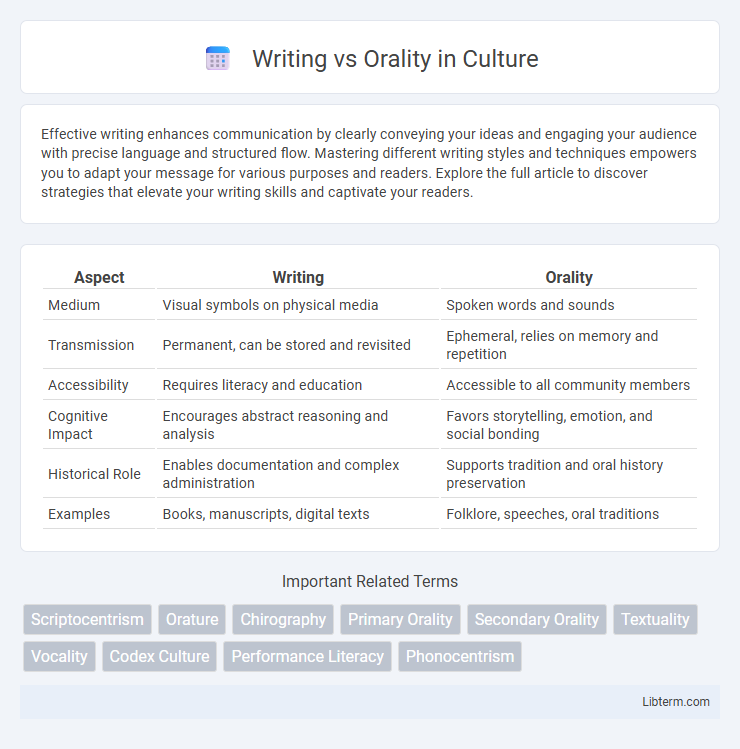Effective writing enhances communication by clearly conveying your ideas and engaging your audience with precise language and structured flow. Mastering different writing styles and techniques empowers you to adapt your message for various purposes and readers. Explore the full article to discover strategies that elevate your writing skills and captivate your readers.
Table of Comparison
| Aspect | Writing | Orality |
|---|---|---|
| Medium | Visual symbols on physical media | Spoken words and sounds |
| Transmission | Permanent, can be stored and revisited | Ephemeral, relies on memory and repetition |
| Accessibility | Requires literacy and education | Accessible to all community members |
| Cognitive Impact | Encourages abstract reasoning and analysis | Favors storytelling, emotion, and social bonding |
| Historical Role | Enables documentation and complex administration | Supports tradition and oral history preservation |
| Examples | Books, manuscripts, digital texts | Folklore, speeches, oral traditions |
Defining Writing and Orality
Writing is the systematic representation of language through visible, permanent marks or symbols, enabling communication across time and space, while orality refers to the oral transmission of language through spoken words, relying on memory and immediate context. Writing allows for detailed record-keeping, complex argumentation, and preservation of knowledge beyond individual lifespans. Orality emphasizes interpersonal interaction, communal memory, and flexible storytelling without fixed textual forms.
Historical Evolution of Orality and Writing
Orality represents the earliest form of human communication, relying on spoken word and memory within tribal societies, while writing emerged around 3200 BCE in Mesopotamia as a revolutionary tool for record-keeping and knowledge transmission. The shift from orality to writing facilitated the development of complex civilizations, enabling the preservation of laws, religious texts, and historical narratives beyond immediate memory constraints. This historical evolution transformed human cognition by transitioning from ephemeral verbal traditions to durable, text-based archives that underpin modern literacy and education systems.
Cognitive Impacts of Orality vs Writing
Orality fosters memory reliance and oral mnemonic devices, enhancing auditory and verbal cognitive skills, while writing externalizes memory, allowing complex abstract thinking and the development of formal logic. Oral cultures prioritize narrative structures and social interaction, which shape cognitive patterns through storytelling and communal knowledge transmission. Written language supports analytical reasoning and long-term information storage, fundamentally altering cognitive processes by enabling reflection and systematic record-keeping.
Cultural Transmission in Oral and Written Traditions
Oral traditions rely on memory, storytelling, and communal participation to transmit cultural knowledge, emphasizing the fluidity and adaptability of narratives across generations. Written traditions preserve cultural information through fixed texts, enabling precise documentation and wider dissemination beyond immediate communities. The interplay between orality and writing shapes cultural transmission by balancing dynamic oral interpretations with the permanence of written records.
Memory and Knowledge Preservation
Writing enhances memory retention by externalizing information, enabling more accurate and long-term knowledge preservation compared to oral traditions. Oral societies rely heavily on repetitive storytelling and mnemonic devices to maintain collective memory but face risks of distortion and loss over time. Written records provide a stable, accessible archive that supports cumulative knowledge accumulation and cross-generational learning.
Social Interaction: Spoken vs Written Communication
Spoken communication fosters immediate social interaction through vocal tone, body language, and real-time feedback, enhancing emotional connection and understanding. Written communication allows for thoughtful reflection, permanence, and the ability to reach a broader audience asynchronously, but lacks the immediacy of face-to-face exchange. The choice between orality and writing fundamentally shapes social dynamics, influencing how relationships are formed and maintained within communities.
Authority and Authenticity in Oral and Written Forms
Orality relies on the speaker's presence and vocal expression to convey authority and authenticity, creating a direct and relational trust with the audience. Writing establishes authority through the permanence and reproducibility of text, allowing for verification and widespread dissemination that reinforces credibility. The authenticity of oral tradition is rooted in communal validation and memory, whereas written forms depend on documented evidence and standardized language to maintain legitimacy.
Technology’s Influence on Writing and Orality
Technology revolutionizes writing and orality by transforming how information is produced, stored, and shared, with digital platforms enabling instantaneous global communication. Writing evolves through word processing software and cloud storage, enhancing editing efficiency and accessibility, while orality adapts via podcasts and voice recognition technology, preserving spoken traditions and expanding reach. This technological shift fosters a dynamic interplay between writing and speech, blending multimedia elements to enrich linguistic expression and cultural transmission.
Blending Orality and Writing in the Digital Age
Blending orality and writing in the digital age transforms communication by integrating spoken language with textual formats across multimedia platforms. Social media, podcasts, and video content exemplify this fusion, enabling dynamic interaction and real-time feedback that enhance narrative depth and engagement. Digital tools such as speech-to-text and interactive transcripts further bridge the gap, fostering seamless transitions between oral and written expressions for diverse audiences.
Future Perspectives on Orality and Writing
Future perspectives on orality and writing highlight the increasing integration of digital media, which amplifies oral communication through podcasts, video content, and voice recognition technologies. Advancements in artificial intelligence and natural language processing enable more interactive, conversational interfaces that blur traditional boundaries between spoken and written forms. This evolution fosters hybrid literacy practices, where oral and written modalities coexist and enhance cognitive engagement and knowledge dissemination.
Writing Infographic

 libterm.com
libterm.com